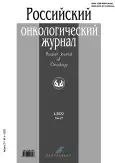Анализ хирургического лечения больных с диагнозом рак поджелудочной железы в Самарском областном клиническом онкологическом диспансере
- Авторы: Каганов О.И.1,2, Орлов А.Е.1,2, Козлов А.М.1,2, Швец Д.С.2, Миколенко Н.И.2
-
Учреждения:
- Самарский государственный медицинский университет
- Самарский областной клинический онкологический диспансер
- Выпуск: Том 27, № 6 (2022)
- Страницы: 267-273
- Раздел: Оригинальные исследования
- URL: https://journals.rcsi.science/1028-9984/article/view/249547
- DOI: https://doi.org/10.17816/onco584093
- ID: 249547
Цитировать
Аннотация
Обоснование. Хирургическое вмешательство — единственный радикальный вариант лечения опухолей головки и хвоста поджелудочной железы. На сегодняшний день оптимальной операцией, применяемой при опухолях головки поджелудочной железы, является гастропанкреатодуоденальная резекция, а при опухолях хвоста — дистальная субтотальная резекция поджелудочной железы и спленэктомия. Основным доступом при данных операциях является срединная лапаротомия. В нашей статье мы анализируем оперативные вмешательства, которые были выполнены по поводу рака поджелудочной железы в Самарском областном клиническом онкологическом диспансере.
Цель — анализ оперативных вмешательств по поводу рака поджелудочной железы в Самарском областном клиническом онкологическом диспансере для оценки непосредственных и отдалённых результатов хирургического лечения.
Методы. В данной статье представлены результаты лечения 236 пациентов с раком поджелудочной железы в отделении абдоминальной онкологии Самарского областного клинического онкологического диспансера с 2018 года по 2023 год. Большинству пациентов были выполнены оперативные вмешательства, включая стентирование холедоха, дренирование желчных протоков и холецистостомию. При неоперабельных или нерезектабельных процессах проводились паллиативные операции, такие как формирование холецистоэнтероанастомоза и гастроэнтероанастомоза. Большинство пациентов были радикально прооперированы, а у некоторых из них операциям предшествовала неоадъювантная полихимиотерапия. В послеоперационном периоде проводились различные методы реконструкции, включая формирование панкреато-гастро-анастомоза и панкреатоеюноанастомоза. Кроме того, были проведены комбинированные операции у некоторых пациентов с инвазией опухолью смежных органов.
Результаты. Исследованы медицинские карты 99 пациентов, прошедших радикальную операцию. У 30 из них возникли значимые клинические осложнения по классификации Clavien–Dindo и включали в себя панкреатическую фистулу, несостоятельность панкреатоеюноанастомоза, несостоятельность панкреато-гастро-анастомоза и подпеченочный абсцесс. Все пациенты прошли лапаротомию, санацию и дренирование брюшной полости, а также продолжали лечение в отделениях реанимации и интенсивной терапии. Некоторым пациентам потребовалась релапаротомия для остановки внутрибрюшного аррозивного кровотечения. Летальность составила 12,02%, причиной смерти в некоторых случаях была несостоятельность панкреатоэнтероанастомоза вместе с панкреатической фистулой, а также сердечно-лёгочная недостаточность, вызванная тромбоэмболией лёгочной артерии. Больные были разделены на четыре группы в зависимости от выполненной операции. Летальность после дистальной субтотальной резекции поджелудочной железы составила 2,02%, после гастропанкреатодуоденальной резекции — 20,9%, а после расширенно-комбинированных операций — 0%. Оценка выживаемости была проведена на основе статистических данных ракового регистра, показавших наиболее высокую пятилетнюю выживаемость после дистальной резекции поджелудочной железы со спленэктомией и самую низкую после паллиативных операций.
Заключение. Хирургическое вмешательство является основным методом лечения рака поджелудочной железы. Радикальная операция является ключевым фактором, который влияет на прогноз заболевания. Однако отсутствие верификации рака поджелудочной железы перед поступлением в больницу не позволяет проводить химиотерапию в режиме дооперационного лечения при распространенной форме заболевания. Примерно у 70% пациентов синдром механической желтухи становится первым проявлением болезни, что требует дополнительных методов диагностики и лечения. Сложность операции заключается в близости поджелудочной железы к сосудистым структурам. Большинство пациентов уже неоперабельны на момент подтверждения диагноза из-за распространения опухолевого процесса. Из-за технической сложности операций, высокой численности осложнений и высокой послеоперационной смертности лечение рака поджелудочной железы следует проводить в больших специализированных центрах. Лечение заболевания требует междисциплинарного сотрудничества для достижения оптимальной диагностики и обеспечения надёжных клинических и лечебных возможностей.
Ключевые слова
Полный текст
Открыть статью на сайте журналаОб авторах
Олег Игоревич Каганов
Самарский государственный медицинский университет; Самарский областной клинический онкологический диспансер
Email: okaganov@yandex.ru
ORCID iD: 0000-0003-1765-6965
SPIN-код: 2705-4187
д.м.н., профессор
Россия, Самара; СамараАндрей Евгеньевич Орлов
Самарский государственный медицинский университет; Самарский областной клинический онкологический диспансер
Email: orlovaesamaraonko@yandex.ru
ORCID iD: 0000-0001-6145-3343
SPIN-код: 8902-5712
д.м.н., доцент
Россия, Самара; СамараАлексей Михайлович Козлов
Самарский государственный медицинский университет; Самарский областной клинический онкологический диспансер
Автор, ответственный за переписку.
Email: a.m.kozlov@samsmu.ru
к.м.н.
Россия, Самара; СамараДенис Сергеевич Швец
Самарский областной клинический онкологический диспансер
Email: shvetsds@samaraonko.ru
врач-онколог
Россия, СамараНикита Игоревич Миколенко
Самарский областной клинический онкологический диспансер
Email: nekit.mikolenko@yandex.ru
Врач-онколог
Россия, СамараСписок литературы
- Егорова А.Г., Орлов А.Е., Сомов А.Н., и др. Злокачественные новообразования в Самарской области в 2020-2021 годы: обзор статистической информации по результатам обработки базы данных Самарского ракового регистра по состоянию на 31.10.2022г. Показатели заболеваемости, смертности, выживаемости и состояния медицинской помощи. Саратов: ООО «Амирит», 2022.
- Костина Ю.Д., Павелец К.В. Диагностика и лечение рака поджелудочной железы современное состояние проблемы // Медицина: теория и практика. 2018. Т. 3, № 3. С. 16–26.
- Katz M.H.G., Marsh R., Herman J.M., et al. Borderline resectable pancreatic cancer: Need for standardization and methods for optimal clinical trial design // Annals of surgical oncology. 2013. Vol. 20, N 8. P. 2787–2795. doi: 10.1245/s10434-013-2886-9
- Расулов Р.И., Шелехов А.В., Манькова Т.Л., Неустроев В.Г. Расширенная гастропанкреатодуоденальная резекция: углубленный клинический и патологоанатомический анализ // Вестник РОНЦ им. Н.Н. Блохина РАМН. 2008. Т. 19, № 1. С. 64–70.
- Кучин Д.М. Выбор оптимального способа формирования панкреатодигестивного анастомоза при гастропанкреатодуоденальной резекции : дис. канд. мед. наук. Москва, 2017.
Дополнительные файлы













